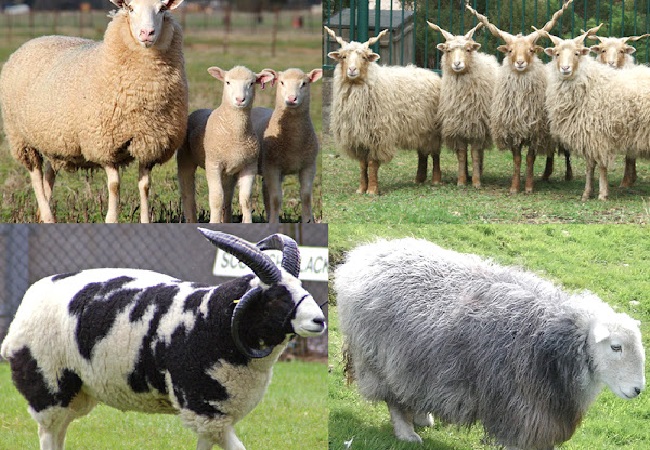Sheep are some of the most adaptable and versatile livestock animals in the world, found everywhere from the freezing cold climates of Iceland to the scorching hot plains of Africa.
There are more than 1,000 Sheep Breeds globally, each with unique characteristics, adaptations, and purposes. This article aims to shed light on some of the most prevalent Sheep Breeds and their diverse roles in human livelihood.

Different Types of Sheep Breeds
Here are some different types of Sheep Breeds:
Read Also:
Merino Sheep: The Wool Producers
Originating in Spain, Merino sheep are most famous for their fine, crimped wool, considered the best in the world. Their superior wool quality and adaptability to diverse climatic conditions make them a popular choice among breeders.
Suffolk Sheep: The Meat Suppliers
Bred in England, Suffolk sheep are primarily raised for meat. They are known for their large size, rapid growth rate, and efficient feed conversion, producing excellent quality mutton and lamb.
East Friesian: The Milk Givers
East Friesian sheep, originally from Germany, are known as one of the best milk-producing Sheep Breeds. They provide a significant volume of milk compared to other breeds and are often crossbred to enhance milk production in other lines.
Key Characteristics of Sheep Breeds
Different Sheep Breeds exhibit unique characteristics. For instance, the Romney sheep, bred in England’s Romney Marsh region, are dual-purpose sheep, known for their long, lustrous wool and good meat quality.
They’re also known for their resistance to foot rot and adaptability to wet conditions. Rambouillet, a French breed, has fine wool similar to Merino sheep but is more adapted to arid conditions.
Icelandic sheep, a northern European breed, is unique for its dual coat, consisting of a warm inner layer (thel) and a weather-resistant outer layer (tog).
The Role of Sheep Breeds in Human Livelihood
Sheep Breeds play a critical role in human livelihood, contributing to clothing, food, and income. The wool from breeds like Merino and Rambouillet is used to produce high-quality garments, while meat breeds such as Suffolk and Dorset contribute to global food supply.
Milk from breeds like the East Friesian is used for specialty cheeses and dairy products. Sheep also play a key role in managing natural resources, as their grazing helps control vegetation and maintain landscapes.
The Diversity in Sheep Breeds: Uncovering Lesser-Known Varieties
Here are some Sheep Breeds:
Icelandic Sheep: The Nordic Heritage
Icelandic Sheep, known for their long history and distinct double coat, are among the few Sheep Breeds that retain their wilder characteristics. They are used for meat, wool, and milk, offering a multipurpose breed for small and diverse farms.
Katahdin: The Hair Sheep
The Katahdin is an American breed that, unlike other woolly Sheep Breeds, grows hair. Named after Maine’s Mount Katahdin, these sheep are known for their hardiness, adaptability, and high-quality meat production, all while being easier to maintain due to the lack of shearing.
Navajo-Churro: The Pioneers of the West
The Navajo-Churro breed is the oldest domesticated breed in the United States, brought by Spanish explorers in the 16th century. They were adopted by the Navajo nation and used for wool, which is still prized for its unique qualities in rug weaving.
Adaptation and Breeding: Creating Ideal Sheep Breeds
Sheep Breeds can also be interbred to create hybrids that possess desirable traits from both parent breeds. For example, the Dorper breed, a cross between Dorset Horn and Blackhead Persian sheep, is an easy-care meat breed adapted for arid conditions.
Another significant aspect of sheep breeding is the ongoing adaptation of different breeds to specific climate conditions, landscapes, and human needs. This diversity and adaptability are part of what makes sheep one of the most globally widespread livestock animals.
The Global Distribution of Sheep Breeds
Sheep Breeds have spread worldwide, adapting to different climates and geographical challenges. From the mountainous regions inhabited by the resilient Scottish Blackface breed to the dry climates where the Dorper and Barbados Blackbelly excel, sheep have proven their robustness and versatility time and again.
Understanding the global distribution of Sheep Breeds further emphasizes the sheep’s ability to adapt and serve humans’ needs in different environments.
Read Also:
Conclusion
Understanding the wide array of Sheep Breeds helps us appreciate the remarkable versatility and adaptability of this livestock species. From wool and meat production to land management, these animals significantly contribute to diverse human needs.
As our understanding of Sheep Breeds continues to expand, we can better utilize their potential, ensuring a sustainable and productive future for sheep farming.
























